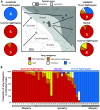The causes and evolutionary consequences of mixed singing in two hybridizing songbird species (Luscinia spp.)
- PMID: 23577089
- PMCID: PMC3618175
- DOI: 10.1371/journal.pone.0060172
The causes and evolutionary consequences of mixed singing in two hybridizing songbird species (Luscinia spp.)
Abstract
Bird song plays an important role in the establishment and maintenance of prezygotic reproductive barriers. When two closely related species come into secondary contact, song convergence caused by acquisition of heterospecific songs into the birds' repertoires is often observed. The proximate mechanisms responsible for such mixed singing, and its effect on the speciation process, are poorly understood. We used a combination of genetic and bioacoustic analyses to test whether mixed singing observed in the secondary contact zone of two passerine birds, the Thrush Nightingale (Luscinia luscinia) and the Common Nightingale (L. megarhynchos), is caused by introgressive hybridization. We analysed song recordings of both species from allopatric and sympatric populations together with genotype data from one mitochondrial and seven nuclear loci. Semi-automated comparisons of our recordings with an extensive catalogue of Common Nightingale song types confirmed that most of the analysed sympatric Thrush Nightingale males were 'mixed singers' that use heterospecific song types in their repertoires. None of these 'mixed singers' possessed any alleles introgressed from the Common Nightingale, suggesting that they were not backcross hybrids. We also analysed songs of five individuals with intermediate phenotype, which were identified as F1 hybrids between the Thrush Nightingale female and the Common Nightingale male by genetic analysis. Songs of three of these hybrids corresponded to the paternal species (Common Nightingale) but the remaining two sung a mixed song. Our results suggest that although hybridization might increase the tendency for learning songs from both parental species, interspecific cultural transmission is the major proximate mechanism explaining the occurrence of mixed singers among the sympatric Thrush Nightingales. We also provide evidence that mixed singing does not substantially increase the rate of interspecific hybridization and discuss the possible adaptive value of this phenomenon in nightingales.
Conflict of interest statement
Figures




Similar articles
-
Limited Song Mixing Without Genomic Gene Flow in a Contact Zone Between Two Songbird Species.Mol Biol Evol. 2023 Mar 4;40(3):msad053. doi: 10.1093/molbev/msad053. Mol Biol Evol. 2023. PMID: 36869752 Free PMC article.
-
Sperm divergence in a passerine contact zone: Indication of reinforcement at the gametic level.Evolution. 2019 Feb;73(2):202-213. doi: 10.1111/evo.13677. Epub 2019 Jan 7. Evolution. 2019. PMID: 30597549
-
Buzzwords in females' ears? The use of buzz songs in the communication of nightingales (Luscinia megarhynchos).PLoS One. 2012;7(9):e45057. doi: 10.1371/journal.pone.0045057. Epub 2012 Sep 13. PLoS One. 2012. PMID: 23028759 Free PMC article.
-
Interspecific competition promotes habitat and morphological divergence in a secondary contact zone between two hybridizing songbirds.J Evol Biol. 2018 Jun;31(6):914-923. doi: 10.1111/jeb.13275. Epub 2018 Apr 18. J Evol Biol. 2018. PMID: 29603471
-
Song Morphing by Humpback Whales: Cultural or Epiphenomenal?Front Psychol. 2021 Jan 15;11:574403. doi: 10.3389/fpsyg.2020.574403. eCollection 2020. Front Psychol. 2021. PMID: 33519588 Free PMC article. Review.
Cited by
-
Opportunities and limitations: A comparative analysis of citizen science and expert recordings for bioacoustic research.PLoS One. 2021 Jun 28;16(6):e0253763. doi: 10.1371/journal.pone.0253763. eCollection 2021. PLoS One. 2021. PMID: 34181671 Free PMC article.
-
The use of network analysis to study complex animal communication systems: a study on nightingale song.Proc Biol Sci. 2014 May 7;281(1785):20140460. doi: 10.1098/rspb.2014.0460. Print 2014 Jun 22. Proc Biol Sci. 2014. PMID: 24807258 Free PMC article.
-
Captive rearing experiments confirm song development without learning in a tracheophone suboscine bird.PLoS One. 2014 Apr 30;9(4):e95746. doi: 10.1371/journal.pone.0095746. eCollection 2014. PLoS One. 2014. PMID: 24788343 Free PMC article.
-
Limited Song Mixing Without Genomic Gene Flow in a Contact Zone Between Two Songbird Species.Mol Biol Evol. 2023 Mar 4;40(3):msad053. doi: 10.1093/molbev/msad053. Mol Biol Evol. 2023. PMID: 36869752 Free PMC article.
-
Interspecific competition, hybridization, and reproductive isolation in secondary contact: missing perspectives on males and females.Curr Zool. 2018 Feb;64(1):75-88. doi: 10.1093/cz/zox060. Epub 2017 Oct 28. Curr Zool. 2018. PMID: 29492041 Free PMC article.
References
-
- Verzijden MN, ten Cate C, Servedio MR, Kozak GM, Boughman JW, et al. (2012) The impact of learning on sexual selection and speciation. Trends Ecol Evol 27: 511–519. - PubMed
-
- Grant PR, Grant BR (1997) Hybridization, sexual imprinting and mate choice. Am Nat 149: 1–28.
-
- Grant PR, Grant BR (1997) Mating patterns of Darwin's finch hybrids determined by song and morphology. Biol J Linn Soc 60: 317–343.
Publication types
MeSH terms
LinkOut - more resources
Full Text Sources
Other Literature Sources
Miscellaneous

